High power lasers are used in the industry routinely for cutting, drilling, welding and micromachining materials. They have also found applications in medicine where tissue needs to be cut or heated. The need for higher power lasers has seemed to increase steadily over the years. Diode lasers, which are usually used for low power applications, seem to give reasonable output powers when used as a diode laser array. They have found applications in medicine where moderate output powers are required. This article will discuss the structure and process for getting high powers in laser diode arrays, with novel applications in spectral combining and parallel optical links.
Diode laser array using VCSELs
Typical single mode VCSEL laser output is on the order of a few milliwatts. For telecommunication applications, this would suffice. However for high power applications, the power output of the laser must be orders of magnitude higher. It is hard to reach such magnitudes from a single VCSEL as there is simply not enough current density and efficiency in conversion that can be achieved. Instead, the output of many VCSELs are combined and collimated to give a high power collimated beam. Output of 230 W has been demonstrated using such arrays. The image below shows such a stack focused using a microlens array.

VCSEL array focused by microlenses. Courtesy of Princeton Optronics.
Fabrication
Patterning and layer deposition can be done by techniques such as molecular beam epitaxy (MBE) where the thickness of each layer is controlled. The image below shows the various steps that go into the processing of VCSELs. While making devices for high power applications, an array of lasers is cut together instead of individual pieces. Care must be taken to place proper heat sinks to drain away the excess heat generated from these devices.
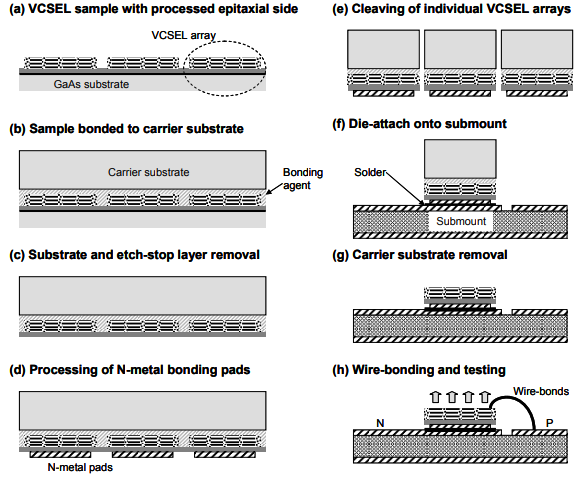
Fabrication, cleaving, testing of individual VCSELS. For laser arrays, a set of lasers are cleaved together instead of individual ones. Courtesy of Springer.
Edge emitting array
While edge emitters do not have superior spectral qualities as the VCSELs, individual devices can give higher output powers as the gain interaction length is longer and operation can be multi-mode thus enabling more power to be guided in the cavity. Because of this reason, higher energies maybe obtained, but the reliability and yield factors remain an obstacle. The schematic below show how an edge emitting laser diode array can be formed by a sequence of stacks.
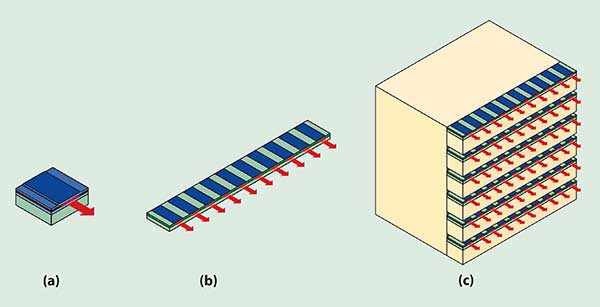
Edge emitting arrays stacked for high power applications. Courtesy of Photonics.com
Usually an external lens is used to focus the individual output beams to create a single high power output beam.
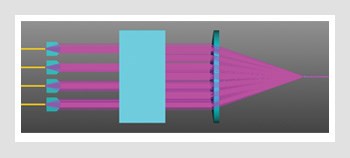
Schematic for combining the individual laser beams to form to a single high power output beam.
Applications
The high power laser market is dominated by solid-state and gas lasers. High power laser diode array can be coupled into fiber optics to be used for medical applications. However, apart from competing with solid state lasers, the novel structure of many laser diodes in an array opens up some unique applications.
Spectral Beam Combining
The individual laser diodes can be designed for different wavelengths and modulated separately to emit beams with different wavelengths. A spectral beam combining system is then used to convert the individually spaced beams into a single output beam. The combining system typically uses a lens and a diffraction grating. The schematic for the setup is shown below.
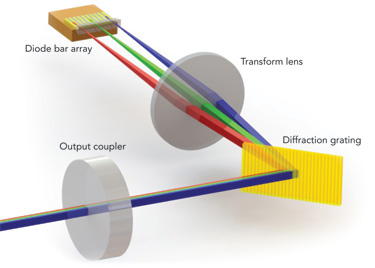
Spectral beam combining using a diffraction grating. Courtesy of industrial-lasers.
The lens focuses the individual beams to a single spot on the diffraction grating. Then based on the correct angular position of the grating, the beams will diffract into a single beam. The beams combined this way not only have a high output power but also have a range of frequencies that can be useful in spectroscopy. For example, in infrared spectroscopy to probe molecules, a set of frequencies can be used to observe the various absorption wavelengths simultaneously. Quantum cascade laser (QCL) based laser diode array has been used to obtain the absorption spectrum of isopropanol even from a distance of a few meters.
Parallel optical links
Optical fiber links use VCSELs that can be modulated at tens of GHz for sending bits of information down the core. Increasing the speed of a single VCSEL is harder and thus speeds above 40 GHz or so are hard to obtain. Developing parallel optical links solves this problem.
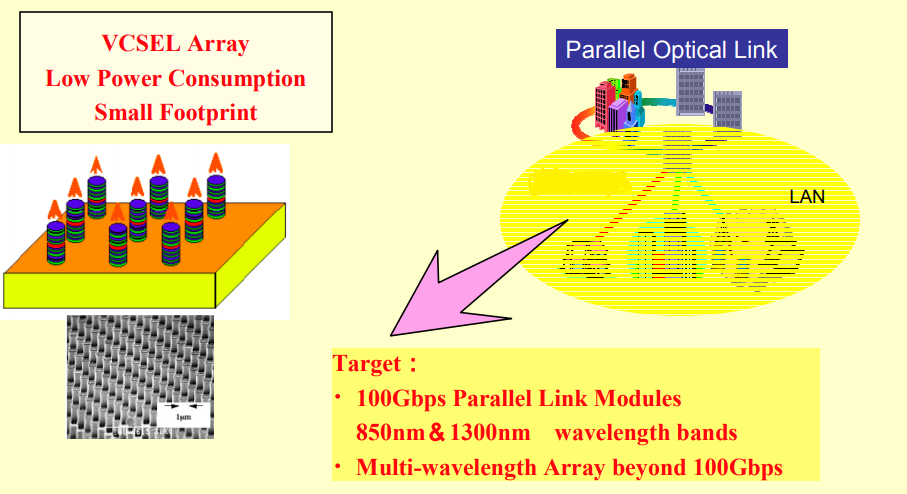
Use of parallel optical link modules in LAN. Data transfer at 100 Gbps or greater can be achieved.
In such modules, the data is split among many fibers rather than one. This way data transport of 100 Gbps and higher can be obtained. Applications of laser diode array modules with parallel optical links have been proposed for fast automatic data collection from particle accelerator experiments in CERN. A huge number of data points is collected each second and stored to be processed later. Fiber optic cables in a parallel network can provide the necessary speeds for collecting data.
Pumping solid-state and fiber lasers
Solid-state lasers can be pumped with laser diodes which are referred to as diode-pumped solid state lasers (DPSS). High pumping powers can be used to obtain higher output powers. Similarly, pumping power in fiber lasers using diode arrays is high. Powers greater than a kilowatt have been coupled into a single mode fiber. Such high pumping powers can be used to increase the power output of diode pumped fiber lasers drastically.
Check out FindLight’s collection of diode pumped solid state lasers, fiber lasers, VCSELs, and fiber coupled diode lasers to use in your applications.

Hello is it possible to have an Array of the size 1cm*1cm with 10000 focuspoints, a pulsrate of 0,000625s and inndividually controll the beams and of course what would be the possible power per beam and whats the price range for something like that.
Thanks for reading.